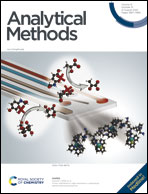Simultaneous determination of ascorbic acid, uric acid and dopamine using silver nanoparticles and copper monoamino-phthalocyanine functionalised acrylate polymer†
Abstract
A silver nanoparticle and copper monoamino-phthalocyanine-acrylate (Cu-MAPA) polymer modified glassy carbon electrode was developed for the simultaneous detection of dopamine (DOP), ascorbic acid (AA) and uric acid (UA) using voltammetric techniques. Silver nanoparticles (AgNPs) were synthesised according to the citrate reduction method. Following synthesis and characterisation the copper phthalocyanine polymer was co-deposited with AgNPs realising a surface with enhanced electron transfer which lowered the overpotential required for analyte electro-oxidation. Differential pulse voltammetry (DPV) was employed for the simultaneous determination of dopamine (DOP), ascorbic acid (AA) and uric acid (UA) at AgNP/Cu-MAPA modified surfaces at <μM ranges. The peak potential separations for DOP-AA and DOP-UA were ca. 181 mV and 168 mV respectively. The chemical sensor was also capable of individual quantitation of DOP, UA and AA with detection limits of 0.7, 2.5 and 5.0 nM respectively. Overall, the approach realised a simple and effective electrode modifier for the selective discrimination and quantitation of DOP in the presence of physiological levels of AA and UA.



 Please wait while we load your content...
Please wait while we load your content...